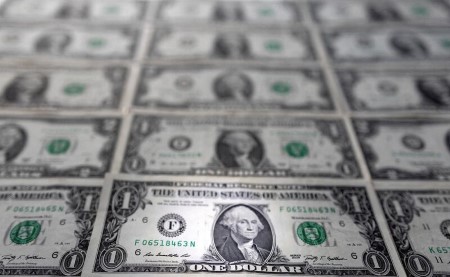




Inflation Update: Prices rise even slower in May
 DOWNLOAD
DOWNLOAD

Monthly Recap: BSP to outpace the Fed in rate cuts
 DOWNLOAD
DOWNLOAD

Quarterly Economic Growth Release: 5.4% Q12025
 DOWNLOAD
DOWNLOAD


TOP SEARCHES
ANALYSIS-As U.S. economy’s exceptionalism fades, so does the dollar

By Tommy Wilkes and Saikat Chatterjee
LONDON, May 25 (Reuters) – The dollar’s rally to two-decade highs appears to have stalled, with doubts growing on whether the U.S. economy will prove as resilient and monetary policy as aggressive as previously expected.
After climbing 10% in three months, the greenback has slipped 3% =USD since May 13. Some reckon that’s because the safe-haven bid sparked by the Russia-Ukraine war has now ebbed. Others say that if the Federal Reserve were to tighten monetary policy significantly it would risk propelling the U.S. economy into recession.
And finally, while U.S. rate hikes will still outpace those in other major economies, there are signs that rate-hike laggards in the euro zone and Switzerland are readying their own policy-tightening campaigns.
On Monday, European Central Bank President Christine Lagarde dealt the dollar a blow, flagging that the bloc’s 8-year long experience with negative interest rates would end by September.
It upended the view, held by many, that the hit from the war would hobble the ECB’s ability to significantly raise rates and sent the euro EUR=EBS 1% higher against the greenback.
“What has been building through all of this and the market has been ignoring has been the European interest rate story,” said Richard Benson, co-Chief Investment Officer at Millennium Global, who has shifted from a “strategically long” dollar position to a “tactically short” trade earlier this month.
A resilient U.S. economy and adverse geo-politics had provided ideal conditions for dollar outperformance, but those are giving way to what Benson dubbed a “mushy” environment where risks of economic slowdown are becoming apparent.
Money markets still flag U.S. interest rates rising by around 175 basis points by year-end. But they now also price some 100 bps of ECB hikes, versus the 20 bps seen just after Russia’s attack on Ukraine.
BNP Paribas analysts said in a note the Fed rate cycle “is now fairly priced” and that they had increased “short” dollar positions versus the Australian, New Zealand and Swedish currencies.
Unless the market sees a new surge in U.S. rate pricing, they predicted “the dollar to decline, as investors resume carry trades,” a reference to buying higher-yielding currencies.
JPMorgan, while still bullish on the dollar, said currency markets were reacting to a shift from “U.S. exceptionalism to a global slowdown which encompasses the United States.”
Indeed, recent U.S. data, from unemployment to housing and business conditions, all hinted at slowing momentum nL2N2XA1WO.
BENIGN CASE?
Conventional wisdom holds the dollar strengthens in the run-up to Fed rate rises, then loses steam. In three out of the last four hiking cycles, the greenback index fell an average 1.4% between the first and last rate increase, Reuters analysis of Refinitiv data showed nL2N2WJ1C8.
Some believe that still holds. Scott Bessent, who runs Key Square Group, said in an investor letter obtained by Reuters the dollar was on its final run, and “when this denouement concludes, we expect a multi-year weakening of the dollar.” Key Square declined to comment on the letter. nL2N2XF175
The dollar’s May 13 peak coincided with a build-up in bullish speculative long positions in the currency to more than $20 billion. But since then those dollar bulls have felt the heat from a near 20 bps fall in Treasury yields US2YT=RR, US10YT=RR.
Analysts at ING said the “benign case” for financial markets would see the Fed pause after hiking rates to 2% in July.
Others reckon the Fed is at risk of hiking excessively, even though inflation is being driven by supply-side pressures that need fixing.
“By tightening too much the Fed risks choking off potential investment, that could help to ease the situation,” said Stuart Cole, chief macro strategist at brokerage Equiti Capital.
Still, even after recent declines, the dollar index is up some 6.3% in 2022, and could quickly resume its ascent if a European recession looks likely or if global investor confidence takes another tumble.
Millennium’s Benson sees the U.S. currency’s current decline extending, yet calling the recent high a peak for the dollar is “a very big call to make.”
King dollarhttps://tmsnrt.rs/3NOP0lB
Fx market positionshttps://tmsnrt.rs/3wL8Yqa
(Additional reporting by Sujata Rao and Svea Herbst-Bayliss; Editing by Chizu Nomiyama)
((thomas.wilkes@tr.com; +44 (0) 7769 955711;))
This article originally appeared on reuters.com





 By Reuters
By Reuters